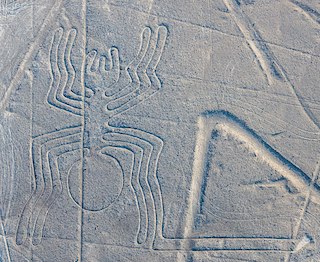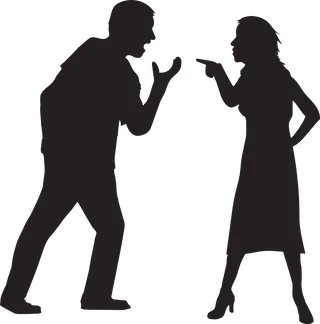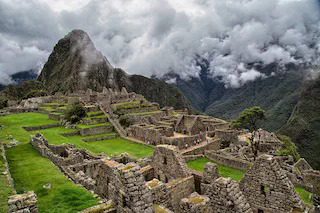
The mysteries of Peru and the 'Fingerprints of the Gods'
- Matthieu P.J.
- Travel
- January 14, 2023
Table of Contents
Following the ‘Fingerprints of the Gods’
I’m on my way to Lima, the capital of Peru, to start a trip I’ve long waited for. And the moment chosen for that trip is special. Because, as I am writing this, the country had riots and civil unrest over the last few weeks, especially in the southern provinces in connection with some recent elections. It seems that political instability has been the rule for many years now. Should that come as a surprise, in a country with so much history, heritage, and high energetic points such as lake Titicaca—which incidentally is the hot area of the conflict?
In his seminal 1995 book “Fingerprints of the Gods” , Graham Hancock starts with Peru and Bolivia on building his case of a lost global advanced civilisation that had once ruled the earth. When he wrote that, Graham had been a journalist for decades as a correspondent in Africa and had traveled extensively across the world. Curious about ancient civilisations, he has made observations on the ground that he links to myths and scientific discoveries across continents. In that fascinating book , he disclosed to the world his findings and instantly became an enemy of orthodox historians. Interestingly, in 2022 he’s produced an 8 episodes documentary series on Netflix called “Ancient Apocalypse” that was on the top most watched on the platform for a few weeks. Could it be that his theories are now becoming mainstream and that he is finally out of disgrace?
I’ll relate some of Graham’s observations below as a taster to the book , and share introductory information for whoever is travelling to Peru. Graham is the grandaddy in the field of ancient civilisations and his theories have influenced many other people who came after him. There’s nothing like reading the book if you want to feel that energy of a breakthrough in ancient civilisations understanding and remembrance of a lost past.
Lima
The trail starts with the Nazca lines, which are patterns formed in an arid part of the country that can be reached from Lima (the capital city) by small airplanes. That area is the Nazca plateau, one of the driest places in the world. There, hundreds of figures representing animals (especially birds) but also geometrical shapes are scattered across large distances.
Spider drawing among the Nazca lines (source: Wikipedia)
But what’s really special is that those drawings can only be appreciated from the air! From the ground, they just look unremarkable. You can observe straight lines that are perfectly straight for up to 5 miles long. Or animals shapes around 50 meters long that are in fact so big that they can’t be appreciated at all from the ground! But there’s no hill or mountain nearby, so how could the artist even check their drawings?
But who has drawn them? Nobody knows for sure. Locals say that some demigods called the Viracochas are the ones who created the Nazca lines (more on them later). Some say they are spaceports for alien visitors. There’s a definitely a mystery about the creation of those designs. What’s even more amazing it that the extent of the mystery was only identified in the 1930s when flights started in the area. Until then, it was considered odd to have those lines in the desert, but no one realised what was drawn: they were missing the ‘big picture’ so to say.
Cuzco (alternative spelling: Cusco)
Graham then moves to Cuzco, further south. Cuzco was the capital of the Incan empire, which ceased to exist after the Spanish conquest in 1532. The conquistadores destroyed much of the Incan culture and brought their own, which could give the illusion today that the city was built by the Spanish but it was not. Similarly, who knows what previous culture the Incas found when they occupied the area centuries ago?
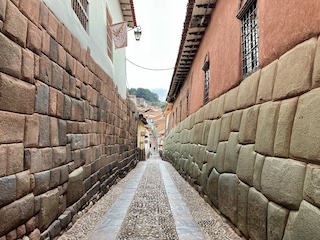
Hatunrumiyoc street in Cusco
We know for example that the cult of Viracocha, a male deity, predates the Incan civilisation itself. We don’t really know how far back in time it started though. In Cuzco, the Coricancha temple is dedicated to Viracocha. In many places around the city, we can see perfectly interlocked stones between which a piece of paper cannot fit (e.g. in the Hatunrumiyoc street such a wall is visible).
The ruins of Sacsayhuaman in Cuzco belong to a civilisation that is even older than the Incan themselves. The precision of the cutting of large block of stones would require a level of technology that was unknown to the Incas. Graham goes on suggesting that a ‘more technically advanced race’ could have been the builders instead. No dating can tell for sure how old Sacsayhuaman is. The fact that the Incan used it does not prove they’ve built it. Just like the Spanish conquistadores built on top of Incan foundations or repurposed existing buildings does not make them the builders. Over time, the knowledge of the real chronology of events got lost and the newcomers made assumptions about their predecessors. It is therefore possible that the Viracochas have built Sacsayhuaman and many other sites.
But, who was this Viracocha? He was a historical figure according to the local stories, but many people like him came too, making it a group of people called the Viracochas. Viracocha was said to be a tall white man with a beard, rather strange considering the appearance of locals. So he was a foreigner for sure. Interestingly, as the conquistadores landed in South America, the Incan thought the gods had returned because they were white men like Viracochas. In fact, the confusion among the Incas is thought to have greatly helped their conquest.
The name Viracocha means Foam of the Sea and it is said he came in a time of chaos and brought with him knowledge of science and magic. Across all the Andes, similar stories are found. There was a great flood, the sun disappeared and darkness was upon the earth, society had fallen into chaos. Most of humanity was exterminated at that time. After that great flood, there was a great reset under the guidance of a benevolent being: Viracocha. Indeed, he educated men and taught them a great deal in many domains such as: science, engineering, architecture, art. He was known by many other names such as Taapac or Kon Tiki. He was a teacher, healer, but also able to conjure fire in the sky when he was threatened, and so he was well respected.
In a nutshell, on his own and simply surrounded by a small group of similar beings, he brought civilisation and its teachings to the locals who lived rather like primitives. That is according to some accounts collected by some conquistadores before the Incan records were lost (destroyed by the Spanish). Viracocha came to Peru, educated the locals then one day left by sea, never to return to this day—although he promised to return one day. Even more mysterious, Viracocha was described as clothed in a white robe, being lean with grey hair, spoking many tongues and walking with a staff. He was even likened to some Christian saints. Seriously, it’s like the archetype of Gandalf in the Lord of the Rings.
On a side note, fortunately Machu Picchu was not salvaged by the conquistadores because it was too remote. It was only in 1911 that it gained international attention, making it a preserved remain of the past. It could be as old a 6,000 years according to some open-minded scholars. But what if it was even much older than that?
Before he came to Cuzco, Viracocha is said to have come to Tiahuanaco near lake Titicaca first. So our story goes there now.
Tiahuanaco (alternative spelling: Tiwanaku)
Further south still is Tiahuanaco. In fact, Tiahuanaco is in Bolivia, across lake Titicaca. The lake itself has one part sitting in Peru and the other sitting in Bolivia. In Tiahuanaco there is an archeological site that is quite unique. And it could have been built in 15,000 BC according to Graham! He cites the work of scientists who provided that age after carefully considering astronomical observations of the buildings alignment at the site. Because of a phenomenon known as the precession of the equinox, the rising of the sun at equinoxes and solstice varies over centuries and millennia. And seventeen millennia ago or so it made sense that the configuration of the buildings would have been what we see now.
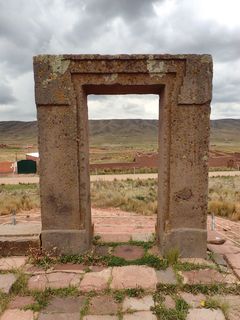
Gate of the Moon in Tiwanaku
In fact, isn’t that an amazing way to leave a clue to future generations about when you’ve erected a building? Granted, it takes astronomical knowledge to come to that conclusion and you would have to wait for a civilisation in the future to be advanced enough to calculate that—in case of some cataclysm that makes people lose the knowledge. But here we are, humans of the 21st century and we can do it!
In proposing those dates, Graham alienated himself from the mainstream historian and archeologists that cannot accept such a gap between their datation (500 BC) and Graham’s (15,000 BC). That’s a factor thirty difference between the two dates!
And we all know that mainstream history tells us that back then there were only primitive humans, isn’t it?
By the way, on a scientific basis, it’s useless to date geological elements (they will be as old as the stone itself so maybe billions of years!), it’s only organic remains that are valuable (typically by analysing Carbon 14 amounts).
So, how could we explain such a discrepancy in dates? Well, according to Graham it’s because humans are a species with amnesia… and we have forgotten something very important about our past. That thing is that a super civilisation once ruled the earth and was wiped out by cataclysms (a deluge and possibly more). That connects with the legends of Atlantis and the likes. But, the ego of modern man can’t quite take it because we like to think we’re the finest that mankind has even been… except it doesn’t necessarily have to be that way!
At Tiahuanaco, temples with enormous pieces of stone (weighing tens of tons) can be seen. Local legends say that the site was created long before the time of the Incas… And those enormous blocks of stones, we have no idea how they were carried there. Some details are also disturbing. For example, carved on a stone an elephant can be seen but they have been extinct since 10,000 BC in that region it is estimated. How can we still deny the evidence in front of us concerning how old that place truly is?
Graham also connects the site with Egypt because of the stone work. Interestingly, in Tiahuanaco traditional boats made from reeds present striking similarities to those sailing the Nile in Egypt. Oh, and there is also the remains of a large pyramid near the temple complex! To the point where we can wonder: was there any exchange between the two ancient cultures of Peru and Egypt?
In Tiahuanaco we know a natural cataclysm occurred around 12,000 BC. The area was submerged by water with great strength (maybe due to earthquakes) and the remains found there prove it. It’s as if sculptors were still carving the stones and had to run away from the catastrophe, leaving literally some stone work unfinished… That is when the Viracochas left, defeated by nature, but after having achieved something of great importance with the building of Tiahuanaco. A place that still stands today!
